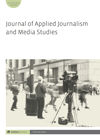
Full text loading...

 , Rana Akbari Fitriawan1
, Rana Akbari Fitriawan1
Corruption in Indonesia is a never-ending and pervasive issue, as the numerous cases prove. Many public officials, businesspeople and private parties have been involved and found guilty in corruption trials. The verdict of the judges’ panel against the accused of corruption cases in Indonesia did not dampen the enthusiasm of several corruption perpetrators who were incarcerated at Sukamiskin Prison in Bandung. This research aims to examine the construction of news in the comics journalism format in Tempo magazine, specifically focusing on how corrupt behaviour in the form of bribery committed by criminals in Sukamiskin Prison is portrayed. This analysis is motivated by the mediatization theory, which is further supported by the mediatization of journalism. This research uses a semiotic-material approach that analyses Tempo comics journalism texts with a focus on elements of symbolism, timing and frames. The research found that Tempo mediated the news about bribery by grafters in Sukamiskin Prison through elements of comics based on journalistic practices. The mediation effort consists of two distinct stages: firstly, journalists on the field engage in the work and, secondly, the composer of the comic constructs the mediation.

Article metrics loading...

Full text loading...
References


Data & Media loading...
Publication Date:
https://doi.org/10.1386/ajms_00123_1 Published content will be available immediately after check-out or when it is released in case of a pre-order. Please make sure to be logged in to see all available purchase options.